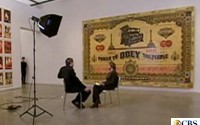
Jonathan LeVine Gallery is pleased to announce its program during the 54th Annual Venice Biennale, The Emergence of the Pop Imagist—a group exhibition presented in association with Bonelli ArteContemporanea. Curated by Jonathan LeVine and Giovanni Bonelli, the exhibition will occupy a former school building called Scuola dei Mercanti, located at: Campo de la Madonna de L’Orto in Cannaregio, Venice, Italy. With an opening reception on June 2 at 6pm, the show will run from June 2—September 15, with hours between 10:30am—1pm and 3pm—7pm, Tuesday—Sunday.
The Emergence of the Pop Imagist features a strong selection of painting, sculpture and digital media, highlighting a diverse assortment of captivating imagery. The exhibition brings together twenty-two celebrated artists who have exhibited at Jonathan LeVine Gallery, including:
Alex Gross, Clayton Brothers, Dan Witz, Doze Green, Erik Mark Sandberg, Esao Andrews, Fulvio Di Piazza, Gary Baseman, Jeff Soto, Jim Houser, Joe Sorren and Jud Bergeron (collaboration), Marco Mazzoni, Mario Martinez (aka Mars-1), Natalia Fabia, Nicola Verlato, Ray Caesar, Ron English, Sam Gibbons, Scott Musgrove, Tara McPherson, Van Arno, WK
A catalogue published by Vanilla Edizioni will accompany the exhibition, with full-color illustrations and essay text written by esteemed New York-based critic, writer and curator Carlo McCormick. This show is possible thanks to contribution by Elisabeth Sarah Gluckstein, the support of the Municipality of Venice and the Province of Venice.
~~~~~~~~~~~~~~~~~~~~~~
The Seduction of the Innocent: Youth Culture & The American Dream Machine
Catalog essay written by : Carlo McCormick
The land of mass mediation, America is torn between its global role as the preeminent purveyor of puerile popular amusements and its own puritanical tendencies. As the germinal home of youth culture, which erupted like an amped-up Technicolor blast of hot rods, board riders, graffitists, rock and roll, naughty girls and bad boys in post-World War II United States, America has simultaneously seduced and shocked itself (along with the rest of the world) by its capacity to generate the unholy carnal spectacle of desire in ever-more polarizing terms of alternately mesmerizing and mortifying seduction and shame. We make our violence so visceral, our lust so explicit, or cute so cloying, our happy endings so impossibly pat, and our morals so unrelentingly absolute it’s as if we need to super-size mythology itself into a corporate designed fast-food mall of commodity consumption whose overreaching market share subsumes the collective imagination in an obviating deluge of titillation and terror. And we do this not simply because it brings immeasurable joy to a vast many but because conversely it manages to piss off an almost equal number into an unreasonable outrage.
This ongoing and fluid tension between wanting and denial has engendered in the split psyche of the new world capital of western consumerism an ideologically charged culture war that- much like our other follies of faith such as prohibition or the war on the drugs, the war on terror or any other number of military conflicts whose vague and indeterminate ends have more often defined only their endlessness—continues on through successive generations over only nominally shifted points of contention. We bring such an odd historical tangent to bear here because, it would seem that these pictures speak most clearly to a culture war of long ago—before the lifetimes of any of these relatively young artists- one in which the righteousness of our hysteric moral indignation temporarily won over our equally zealous passion for pleasure. Amusing for its supreme absurdity by contemporary standards regarding what is now considered appropriate for kids, a war on comic books was launched in 1954 by a vitriolic psychologist named Frederic Wertham through his immensely popular fear-raising book called Seduction of the Innocents in which unsubstantiated anecdote and bizarre reasoning concluded that the sum of our social ills then were a rise in juvenile delinquency that was directly caused by the comics kids were reading.
Much like the Hayes Code of the generation before which caused repression through an industry induced self-censorship (in that case the movie business) or the nearly concurrent hysteria of McCarthyism that it rose its ugly head amidst, the blaming of comics for the unruliness of youth (as we have done so often for everything from rock to hip hop, or television to video games) crushed so much really good art and trashed a wealth of brilliant careers. This winding parable must be cited here for not only the obvious affinity that so many of the image makers in this show have to such a besmirched legacy, nor even for the evident abject lesson we must take that—convenient politics and punditry aside—easy enemies are the least of our worries and surely not the sum of our problems—but because essentially fine art, for all its avant-garde attributes and creative liberties practices its own version of sensual abnegation and intolerant orthodoxy. The art featured in The Emergence of the Pop Imagist resists the ratification of the ruling academy precisely because it embraces the vernaculars and energies of youth in ways that you may not find so easily in the rest of the fare being offered in this year’s Venice biennale season. It is denied membership in such an exclusive club because, well, it does not enjoy aficionados nearly so much as it is awash in real fans.
We offer this observation not just as provocation suitable to the tenor of these artists themselves (for truth be told I have as many pals in the official selections as I do in this rambunctious symbiotic salon des refuses, and am surely just as proud of them) but merely as an excuse by which we might take a moment to measure what this kind of art means to us. Like the lowbrow vitalities that inspired these artists it is almost mystifying to imagine how such pictures could not appeal to us one and all. The problem it would seem is rather that as a culture we inherently distrust the pleasures proffered here as somehow too facile—as if humor, eroticism, beauty, fun and a taste of the nasty are all too recognizable and obvious to mean anything significant anymore. Well, the actual problem is that we have too long doubted the virtues of such exaggerate terms, never willing to speak clearly to one another with our tongues so firmly in our cheeks, and have missed the inescapable truth that these debased, slapstick tropes of representation matter above all because on the street, in the clubs, or wherever fresher minds congregate outside the realm of authority, these lapses in decorum represent emotions and understandings that speak most dearly to who we really are rather than to what those who are less sure of cultural identity pretend to be.






